The Only Way to Use Worksheets in Preschool
Benefits of Using Worksheets
There are a few reasons I like to use worksheets in my classroom:
- Encourage thinking and fine motor skills
- Build stamina and focus needed for kindergarten
- Show parents what we’re learning about
- Easily assess students’ abilities
However, there’s also a lot to consider when using worksheets in preschool. Remember, preschool isn’t kindergarten. There’s a big shift that occurs in a child’s development before they’re ready for formal schooling. Here’s my rules for using worksheets in preschool.
Rules for Using Worksheets in Preschool

#1. Worksheets are Optional
A big reason why play is such an effective means of learning is because play allows children to choose.
So when children are free to make their own choices about completing a worksheet, they feel like they’re playing. But when we offer no choice, children are less engaged and much less likely to enjoy the activity.
Though sometimes we can’t offer choices about behavior and learning to sit still for short periods is a skill they do need to learn before they begin school, our preschoolers just aren’t ready for an hour of sitting at the table doing worksheets.
Instead, make copies of the printable for each student, pass them out at the end of the lesson, and let the children make some choices about how to complete them.
For example, let the kids choose markers or crayons. Or let them choose if they want to cut or color first. By adding some choices, you give the kids some control and make the experience more enjoyable.
If the students don’t want to do papers after you offer choices, then don’t force them. Realistically, they won’t be learning anything from begrudgingly completing a worksheet and are better off exploring the concept through a different kind of play.
#2. Worksheets are for Review
Again, play is context through which preschoolers learn.
So, forcing your students to sit at the table and look at a piece of paper while you talk is so not effective.
Instead, for concepts like shapes, letters, and numbers, try something like a preschool focus wall.
For the rest of your day, read some books about your current theme and set up multiple play opportunities to explore the topic. True play has many choices, feels good, and has no academic goals.
We can also guide our students toward academic objectives by adapting some of the choices available during play and providing examples of how to play.
But ultimately, you should only be using worksheets as a choice in a writing center or passing them out at the end of a lesson as optional review. Don’t make papers the bulk of your preschool lesson.
#3. Worksheets Should Be Short and Fun
Making table work too long or complicated are guaranteed to make your students feel like they’re working instead of playing.
All of the worksheets you’ll find in my Teachers Pay Teachers store are short and can be completed quickly.
To amp up the level of fun, I like to use interactive notebooks! Preschoolers love books and they love to cut, color, and glue to make their own! Here’s some interactive notebooks available in my shop:
#4. Worksheets Must Be Developmentally Appropriate
Worksheets aren’t tons of fun for most preschoolers. So to encourage using worksheets for the benefits listed above, we need to make sure our printables are as fun as possible!
That means they can’t be too challenging. In fact, the best play allows for mistakes and learning to occur naturally. Grading papers or telling a student that they didn’t complete the paper “right” is not appropriate for preschool.
Instead, a worksheet like this one where students can explore a concept on their own is actually developmentally appropriate.
Shop for Preschool Printables
Do you have students who love completing papers? Or are you looking for some review printables to offer with your lessons?
You can find developmentally appropriate preschool worksheets in my shop!













Leave a Reply